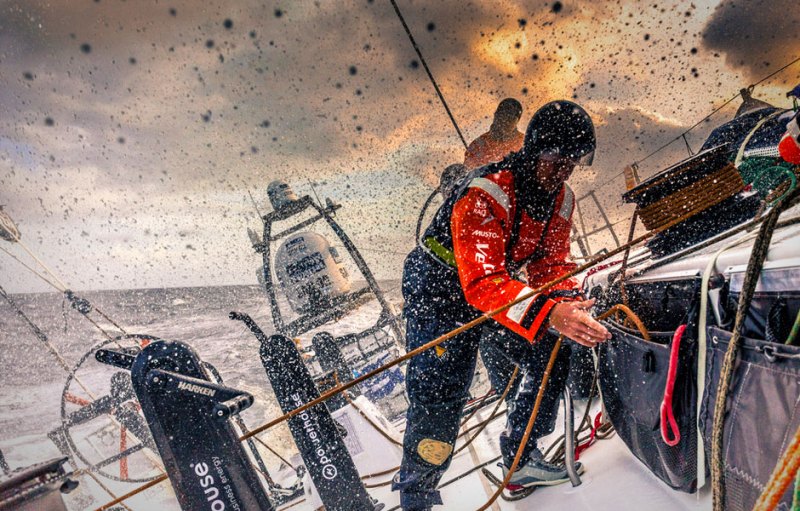
I’m talking of course about the Volvo Ocean Race, one of the most grueling sporting events in the world. The race pits the best open-ocean sailors in the world against each other and the elements, in a nine-month race to circumnavigate the world.
Sailors face the most challenging conditions and, thanks to satellite technology, the internet and onboard reporters, videos, photos and team tracking data are available anytime online. We spectators essentially have front-row seats in the South Pacific. And it’s incredible.

The race itself is as intense as it gets. One boat, Team Vestas Wind, already struck a reef in the Indian Ocean in the dead of the night on Leg 2 leaving the sailors stranded in the middle of nowhere. The footage of the crash, which came online a few days after the team was rescued, is terrifying. A dark night cruising up the coast of Africa, where once in past races pirates were a concern, is interrupted by a crack and a sudden crash into a reef. The sailors are violently hurled across the deck while curse words fly.
Even with this devastating incident, it’s a much better start than the last race in 2011, when only half the teams finished the first leg. In that race, Team Puma was de-masted and was marooned for a spell on a small island in the South Atlantic called Tristan da Cunha. It’s been called the most remote inhabited island in the world. Then there’s all the debris in the water to avoid and, of course, whales.
Round the world sailing races are nothing new. The Volvo Race used to be known as the Whitbread Round The World, which started in 1973. But unlike the early Whitbread races, there are few things that make the current competition even more interesting to a much broader audience.
The Boats
They are blisteringly fast. This year marked the first time the Volvo Ocean Race instituted a one-design, which essentially means every team has the same boat. Unlike other races, which pit teams with wealthy benefactors against, well, less wealthy benefactors, in the Volvo Ocean Race, the boats really are pretty equal. This means it’s crew vs crew, and crew vs ocean.

Just because the boats are bankrolled by wealthy tech entrepreneurs, doesn’t mean they don’t haul. The boats are capable of speeds just shy of 50 mph and can cover some 600 miles in a day. Imagine driving a car with no windshield in the pouring rain at 50 miles per hour, and you begin to get a sense of what sailing a Volvo Ocean Race boat may feel like…day in, day out.
The Course
Nine Legs and 38,000 miles around the world in nine months. Calling it a marathon would be a vast understatement. Sailors leave their wives, husbands and children behind and push their bodies and their boats to the max to compete for the better part of year, and that doesn’t even include the training.
The race is currently in it’s 3rd of nine legs. Boats are sailing right now from Abu Dhabi to Sanya China. After that, it’s onto Auckland, NZ and then perhaps the most intense leg of the race through the Southern Ocean around Cape Horn and up to Brazil. This Southern Ocean leg featured some of the more intense footage that came from the 2001 race, like this giant knockdown.

After each leg, teams have layovers in port cities that allow for fans to come see the boats and also for the teams to get some much needed rest and the boats, much needed repair.
Thinking about stopping by a race village? If you’re in the U.S. you’re in luck this year. The Volvo Ocean Race will be stopping in Newport, RI in the beginning of May. After that you’ll need to get to Lisbon, Portugal, Lorient, France or Gothenburg, Sweden for the finish.
Onboard Reporters
The one thing that’s made the Volvo Ocean Race so captivating for audiences are the onboard reporters. They are essentially considered members of the crew, but instead of sail handling or navigating, their sole job is to capture the action anyway they can, and transmit that to audiences on shore. And they do an amazing job. The conditions they work in – photographing, video editing, blogging, etc. – are challenging to say the least.
Even if you didn’t grow up sailing off Nantucket, there’s action in the Volvo Ocean Race that should attract pretty much any adventure or athletic-minded man and it’s all brought right to your computer. Or, think about it this way, next time you’re having Wi-Fi troubles, consider one of those reporters sailing around Cape Horn trying to upload a photos to Instagram.
Life onboard a Volvo Ocean Race is about as intense as it gets, and we get to witness it all from the comfort of our living rooms.
Photo credit, top to bottom: Brian Carlin/Team Vestas Wind/Volvo Ocean Race; NCG Operations Room – MRCC Mau; RMarc Bow/Volvo Ocean Race; Amory Ross/Team Alvimedica/Volvo Ocean Race


